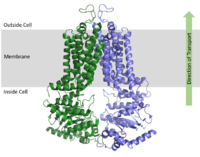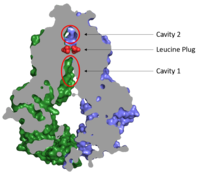Background
The ABCG2 multidrug transporter is a membrane protein from the ATP-binding cassette (ABC) transporter family, specifically the G-subfamily. Also know as the breast cancer resistance protein (BCRP), ABCG2 has physiological roles in various tissue cells including the mammary gland and the blood-brain, blood-testis, and maternal-fetal barriers.[1] ABCG2 protects cells by exporting xenobiotic molecules out of the cell using ATP hydrolysis. ABCG2 also affects the pharmacokinetics of many drugs and contributes to multidrug resistance.[2]
Structural highlights
ABCG2 is a homodimer with each dimer containing two domains, the nucleotide binding domain (NBD) and the transmembrane domain. The NDB is located inside of the cell while the transmembrane domain is located in the cell membrane.

Figure 1. Domains of ABCG2 Multidrug transporter
ATP Bound and Unbound Conformations
As an ABC Transporter, ABCG2 exhibits ATPase activity in which it binds and hydrolyzes ATP in order to cultivate the energy needed for the transport of molecules across the cell membrane. Two molecules of ATP bind the
Cavities and Leucine Plug

Figure 2. Locations of Cavities 1 and 2 and the Leucine Plug in ABCG2.
Disease
Cancer
ABCG2 contributes to multidrug resistance in cancer cells by exporting anti-tumor drugs out of cells which introduces an obstacle in cancer treatment.[1]
brief description of the cancer genes listed in the papers (papers talk about how some cancers had more expression of abcg2 genes)
ABCG2 as a Target for Inhibition
Talk about how and why it would be a good target for the treatment of cancer and include paper talking about inhibition of it


